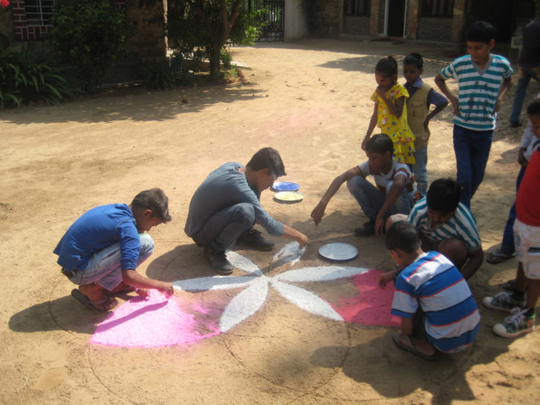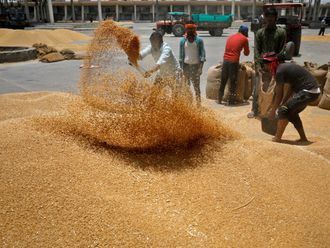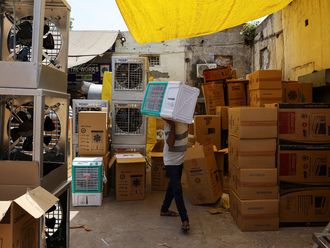
It is not common for the children of the Banjara, a nomadic tribe, to study. Children work with their parents as labourers and are married well before they turn adults. But, Amar Lal is an exception on both counts: he is studying law in a Delhi college, and is a bachelor at 18. He is also the most educated in his neighbourhood in Jodhpur.
In December 2001, when he was barely 5, some activists from the Bachpan Bachao Andolan (BBA), a grassroots movement against child labour started by Kailash Satyarthi, joint winner of this year’s Nobel Peace Prize, spotted him helping his parents as they dug a ditch to lay telephone cables. Amar Lal’s two elder brothers, Pooran and Dhara, were also working at the site. The BBA activists explained to their parents the importance of educating their children and told them that the organisation looked after children like Amar Lal at an ashram. After some initial reluctance, the parents agreed to send their sons to the ashram.
Today, Amar Lal, 18, is happy his parents agreed to send him to Bal Ashram at Viratnagar, 90 kilometres northeast of Rajasthan’s capital, Jaipur. “It changed my life,” he says in between overseeing preparations for a grand welcome the inmates of the ashram have planned for Kailash Satyarthi and his wife Sumedha, who are visiting Viratnagar for the first time after the Nobel Prize announcement. It is a day before Diwali, the Indian festival of lights and firecrackers, and the children are excited. The couple always celebrate festivals with them at the ashram. But this time, it is more special: Satyarthi is now a Nobel prizewinner.
“I got a chance to study, and am now an inspiration for children of my community,” Amar Lal proudly tells me. “At 9, I presided over a session in the ‘world congress for education’, where, besides people from all the Indian states, delegates from 45 countries participated.”
Amar Lal is just one example of how the Bal Ashram, a transitory rehabilitation, educational, training and cultural development centre, has transformed the lives of freed child labourers. At the last count, more than 1,000 children had been rehabilitated at the ashram.
Spread over 5 hectares in the foothills of Aravalli mountain range, the Bachpan Bachao Andolan, which translates as Save Childhood Movement, set up Bal Ashram in 1998 rehabilitate child labourers. When the children are brought to the ashram, they usually have suffered years of mental and physical trauma. The ashram helps them become self-supportive and self-confident individuals who can overcome the traumatic spells of their past and be agents of change in their immediate surroundings.
The ashram has boarding rooms for the children, a prayer room, a library, a dining room or “mess” as it is referred to here, and can accommodate 120 children in a batch for six months.
“There’s an interesting story behind how we made the ashram,” says Sumedha, Kailash’s wife, who is ashram’s director. “My daughter Asmita was invited to speak at the US Congress in 1996. In the same trip, she also spoke at the national convention of the Canadian Labour Congress in Vancouver. The convention usually chooses social causes they want to fund. Asmita spoke about the children that we rescue, and she got $10,000 [Dh36,700]. It was with this money that we bought land and constructed the ashram. They also provided for the maintenance for three years.”
Asmita, who is pursuing her MBA at Hyderabad’s Indian School of Business (ISB) after having worked in the US and with the UN in Geneva, remembers how she motivated the Canadian Labour Congress into funding the project. “I grew up with these children, so it was only natural for me to tell the US Congress and the Canadian convention that we wanted to do more for them so they could study. I was only 10, a student of sixth grade in a Delhi school, but I had been involved with the rescued children at our Delhi ashram since childhood,” says the 29-year-old who has never worked with BBA in an official capacity.
Sumedha tells me that she aims at the holistic development of the children at Bal Ashram. “We train them on six aspects: social development, conventional education, vocational education, health and physical education, leadership development and cultural education,” she says while looking at the posters that the children have prepared to welcome “bhai saab”, as they like to call Kailash Satyarthi.
The children are given a non-formal education for six months, which includes the basic education on language, mathematics, general knowledge, science and discipline, since most of the rescued children have never been to a school before. After the initial six months, many go for formal education at the government secondary school in Sothana village, followed by the senior secondary school at Viratnagar. Those who are not inclined towards education get vocational training in six trades — carpentry, tailoring, painting, welding, motor winding — after they turn 13.
“We have evening classes for them on subjects such as child rights, child labour, gender bias and moral science. We believe that systematic change can only be achieved when the victims themselves become change agents against the exploitation and abuse that they have suffered in the past,” Sumedha adds.
Bal Ashram’s manager Nirpendra Singh, who has a masters in social work from Mahatma Gandhi Kashi Vidyapeeth in Varanasi, shows me around other facilities such as a multipurpose cultural hall. Across the road (Viratnagar-Paota Road off the Jaipur-Alwar highway) is the Balika Ashram, where guestrooms for international volunteers and researchers have been built, besides a vocational training centre for girls from neighbouring villages. Singh, who has been in charge of the ashram since 2007, tells me that there are now 65 children in the ashram, almost 30 of them in the 14-15 age group.
Abhinav Prakash, a coordinator at the ashram, talks about the leadership development initiative. “A committee is elected by children themselves in a democratic manner for overseeing food supply, maintenance, security and discipline,” he says. “This creates a sense of responsibility and accountability in them.”
Like Amar Lal, many other outstanding ashram students have gone abroad to address the European Parliament, US Senate and UN Assembly.
Kinsu Kumar, 19, is one such bright student. Freed in December 2003 from Mirzapur, in southeastern Uttar Pradesh, where he was cleaning private vehicles, he was only 8 years old when he was brought to the ashram. He had never been to a school before. But, only four years later, in 2007, he was addressing the US Senate in Washington and speaking at the EU headquarters in Brussels, Belgium, as a child representative. He also attended the global child labour conference in The Hague in Holland in May 2010.
“When I came here, I thought I will return after a year or so,” says Kinsu, who has come to meet “bhai saab” and “bhabhiji” (Sumedha Kailash), “but I experienced so much love, freedom, care and protection here that I couldn’t leave the ashram before completing my school. The surroundings of the ashram reminded me that I am a free and independent person.”
“The ashram,” he continues, “taught me my rights and how I can start a new life.” Kinsu took admission in the fourth grade in the Sothana government school after the initial six months, and is now in the second year of a bachelor’s degree in technology (BTech) at an engineering college in Alwar, the neighbouring district.
There are many, like Sunil Kumar Yadav, 22, who didn’t stay in the ashram for long, but instead became agents of change working to eradicate child labour. Sushil was rescued from a brick kiln in Saharsa, Bihar, where he was a taken in as a bonded labourer to recover his parents’ debts. “I had been working there for six years before I was rescued,” he says. He spent one and a half years at the ashram and then returned to his village, Ghina, 19 kilometres from the Saharsa district headquarters, where he began school in eighth grade while working to liberate other child labourers like him.
“I have rescued 73 children so far,” he says. He is also studying engineering with Kinsu. “After 12th grade, I came to meet ‘bhabhiji’. She asked me what I wanted to do. I told her I wanted to do engineering and here I am.”
Sumedha has also been instrumental in spreading the message in the ashram’s neighbourhood through the implementation of model child-friendly villages (Bal Mitra Gram), which aim at the elimination of child labour; enrolling the children in schools through active community participation; and the establishment of children’s parliaments, their recognition by the panchayat and then solving the problems highlighted by children. Children not only raise issues that concern them directly, say in schools, but also bring to light many social evils such as alcohol abuse and child marriage.
The first Bal Mitra Gram (BMG) was formed in Papri village, near the ashram. The success of Papri inspired other neighbouring villages to adopt the concept. Today, there are 317 BMGs across 11 states. Girls from BMGs around Viratnagar attend vocational training classes at the Balika Ashram.
The ashram also runs schools for children of the Banjara community. “There are five such schools — in Bilwari, Khori, Neemdi, Bhangdoli and Jodhawas villages — in the Viratnagar area. We provide children free stationery as an incentive for coming to school,” says Adesh Sharma, BMG field coordinator.
Bal Ashram, Sumedha says, does not only offer rehabilitation to children rescued from brick kilns, carpet weaving, stone quarries, agriculture, etc, but it also generates awareness in the community about the injustice of trafficking and forced labour. It educates and empowers communities to stand up for the elimination of child labour and encourages leadership for social justice, equity and peace in village communities. “Our aim is to transform children who have seen the worst into agents of change against exploitation and abuse,” she sums up.
Rakesh Kumar is a writer based in Jaipur, India.













